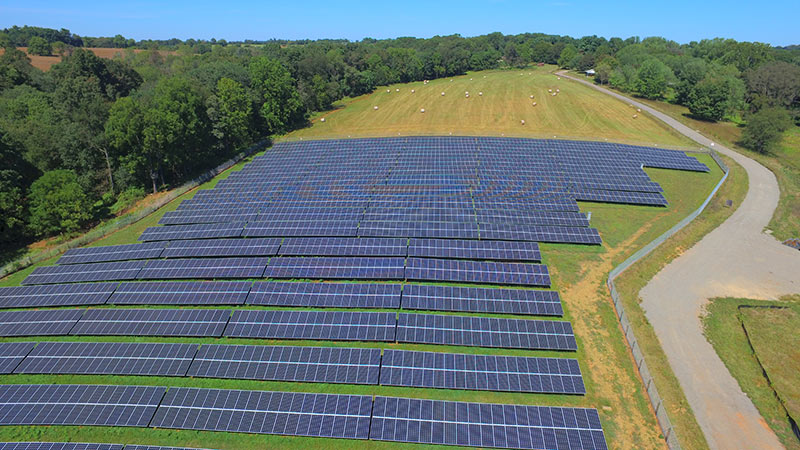Benefits and Overview of Community Solar
December 20, 2021 / by Taylor Ferrani
Solar energy can offer customers a variety of benefits, such as utility bill savings, energy independence, and the chance to support clean and renewable energy. However, many Americans, who are unable to host a solar system on site, are currently unable to realize these benefits. Programs such as community solar – sometimes referred to as shared solar or solar gardens – provide an alternative by allowing people to subscribe to large-scale community solar projects. Under community solar, the solar energy produced by the community solar project is divided among the multiple subscribers and is compensated to their utility bills in the form of a bill credit. Unfortunately, community solar is not currently available in every state. To date, only 20 states have passed legislation which permits community solar[1]. Additionally, each state’s community solar rules can vary significantly from each other. As community solar continue to expand, it is important to understand what makes a community solar program successful and which states may be the next community solar front-runner.

Minnesota has been regarded as having one of the most successful community solar programs in the country. Since its first inception in 2014, 415 projects with a total capacity of 819 MWs have been completed and it is estimated that these projects have generated approximately $2.2 million in energy savings alone[2]. The success of Minnesota’s community solar program has largely been attributed to its lack of a system size cap, while most other states have a project cap around 1-5 MWs. This allows larger projects, with a greater number of subscribers, to be built. However, it is also important to note that Minnesota’s community solar program has been criticized in the past for lacking any environmental justice carveout or incentive. Other state established community solar programs, such as Colorado and New York, have mandated that a specific percentage of subscribers must be low-income as a way to ensure maximum accessibility to solar for all across the state. With demand for community solar continuing to grow across the nation, many states are looking to Minnesota’s program as a template for their own program.
States such as New Jersey, Maryland, Hawaii, and Illinois are currently using temporary community solar pilot programs to gather data that will enable them to establish an effective permanent community solar program. New Jersey’s pilot program has recently proven to be a particular success. The program has approved approximately 242 MWs of community solar in its first two years, and as a result of this success, the program is being made permanent a year earlier than originally planned[3]. However, other states have been facing stronger opposition in their efforts to establish a community solar program. Pennsylvania has tried to pass various legislation permitting community solar for two years but with no success. Despite this, many experts say that community solar in Pennsylvania is only a matter of time and, that once permitted, is likely to expand quickly[4] . Overtime, more states will continue to establish new community solar programs, making solar more accessible than ever before.
With state community solar programs varying in status and rules, if you are interested in participating in community solar, either as a developer or a subscriber, it is important to research your state’s specific program. As more people continue to participate in community solar programs, and demand for solar increases, the price of solar will continue to drop. As a result, clean energy will be accessible and affordable for all.
Core Development Group is interested in speaking to land and property owners for community solar development. If you have 5 to 100 acres of land or a large building with an unobstructed flat roof (over 100,000 square feet), your property may be a good candidate for a community solar facility. Land with degraded usage, limited road frontage, quarry sites, brownfields, unused farms, and landfills are excellent candidates for solar development and can qualify to receive long-term lease payments. Core Development Group can assess your land and provide a competitive lease payment rate for installing solar on your property. Leasing is simple. All the details of your solar farm project are handled, including environmental studies, permits, entitlements, and interconnections to the utility. Core Development Group is actively seeking properties in Maryland, New Jersey, New York, Massachusetts and other states for community solar projects.
Property owners or site hosts have the power to sell or lease their property for solar power production and receive financial compensation. If you are interested in leasing your land or roof for community solar or interested in hosting a solar project, contact Core Development Group today. You can rely on our experience, knowledge, and resources to develop the right solar project with the highest financial incentives for your land or property.
Get more information about Community Solar
[1] Farrell, Maria McCoy and John. “National Community Solar Programs Tracker.” Institute for Local Self-Reliance, December 13, 2021. https://ilsr.org/national-community-solar-programs-tracker/
[2] McCoy, John Farrell and Maria. “Why Minnesota's Community Solar Program Is the Best.” Institute for Local Self-Reliance, November 29, 2021. https://ilsr.org/minnesotas-community-solar-program/
[3] “Community Solar: NJ OCE Web Site.” Community Solar | NJ OCE Web Site. Accessed December 17, 2021. https://njcleanenergy.com/renewable-energy/programs/community-solar/
[4] McDevitt, Rachel. “Solar Companies Are Eyeing Pa. Farmland. A Legislative Agency Is Looking at Ways Communities Can Prepare | Stateimpact Pennsylvania.” NPR. NPR, October 1, 2021. https://stateimpact.npr.org/pennsylvania/2021/10/01/solar-companies-are-eyeing-pa-farmland-a-legislative-agency-is-looking-at-ways-communities-can-prepare/
Get more information on community solar